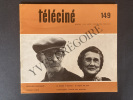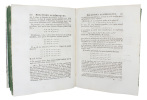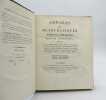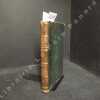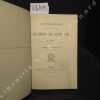-
Type
Book (34)
Magazine (5)
-
Century
18th (4)
19th (12)
20th (8)
21st (1)
-
Countries
Denmark (17)
France (21)
Switzerland (1)
-
Syndicate
ILAB (23)
SLAM (6)
CINEMA ET TELEVISION-N°443-27 FEVRIER 1969
32 PAGES-20,5 CM X 27 CM-EN COUVERTURE GROS PLAN DE JEAN-PIERRE LEAUD-LE GRAND AMOUR, PIERRE ETAIX, 2P, 5 PHOTOS-METTRE LA VIE DANS LES FILMS ENTRETIEN AVEC MAURICE PIALAT, 2P-INTERVIEW DE CLAUDE LELOUCH, 2P, 2 PHOTOS-LA PISCINE, JACQUES DERAY, 1P-FUNNY GIRL, WILLIAM WYLER, 1P, PHOTO BARBRA STREISAND-THEOREME, PASOLINI, 1P-LE DIABLE PAR LA QUEUE, 1P, PHOTO-LA FEMME INFIDELE, CHABROL, 2P, PHOTO-L'AMOUR FOU, JACQUES RIVETTE, 2P, PHOTO-(DE0917)
COUVERTURE SOUPLE ETAT TRES BON
LE FIGARO LITTERAIRE-N°1187-DU 3 AU 9 FEVRIER 1969
52 PAGES-26,5 CM X 36 CM-LE TROUBLE EST DANS L'EGLISE III LA PAROLE EST AUX FIDELES, PAR PIERRE FISSON CLAUDE JANNOUD ET JEAN PRASTEAU, 4 PAGES-1769 1969 NAPOLEON BONAPARTE SA MAJESTE TRES CHRETIENNE L'EMPEREUR NAPOLEON, PAR DOMINIQUE JAMET, 3 PAGES, L'ITALIE SOUS LES AIGLES, PAR RENZO DE FELICE, 1P-L'UNIVERSITE IMPERIALE: UN SYSTEME EFFICACE EN SON TEMPS, PAR ANTOINE PROST, 1P, 2 LETTRES POUR NAPOLEON.CONTRE NAPOLEON-INEDIT: ALAIN ROMAIN ROLLAND LA CORRESPONDANCE DE DEUX GRANDS ESPRITS, 2 PAGES, 2 PHOTOS-LA CRITIQUE DE ROBERT KANTERS: FREDERIC II EXCOMMUNIE ET CROISE, 2P, PHOTO-LES SCIENCES HUMAINES NE PREVAUDRONT PAS SUR L'HUMANISME, PAR PIERRE HENRI SIMON, 2P-ON DEMANDE UNE SOCIETE PROTECTRICE DE LA NATURE, PAR JEAN PRASTEAU, 2P, 2 PHOTOS (GRANDS TRAVAUX, CIMETIERE DE VOITURES)-VOICI ENFIN LA GRANDE ALLIANCE DES TRANSPORTS ET DE L'HOTELLERIE, PAR GILLES LAMBERT, 2P, PHOTO-PEINTURE, PAR CLAUDE ROGER MARX: NON AUX MAITRES D'ECOLE PRIMAIRES!, MONDRIAN, MUSEE DE L'ORANGERIE-KLEIN, LE PALADIN MONOCHROME, PAR FREDERIC MEGRET, ARTS DECORATIFS, RUE DE RIVOLI-SUR LES CIMAISES, PAR FREDERIC MEGRET: FRANCINE DEL PIERRE, MARTIN SCHMID, GALERIE LAMBERT, ROLAND MICHENET, GALERIE DANIEL GERVIS-THEATRE, PAR JACQUES LEMARCHAND: "LE CHANT DU FANTOCHE LUSITANIEN" DE PETER WEISS AU CENTRE THEATRAL DU LIMOUSIN, 1 PAGE, PHOTO-CINEMA, PAR CLAUDE MAURIAC: NEUFS FILMS A VOIR, THEOREME, SIENCE ET CRI, GOTO L'ILE D'AMOUR, LA VOIE LACTEE, L'ENFANCE NUE, FUNNY GIRL, LE DIABLE PAR LA QUEUE, LA PISCINE, LA FEMME INFIDELE, 1P, PHOTO "SILENCE ET CRI"-LIFAR, L'ETERNEL ENFANT, PAR CLAUDE ROSTAND, PHOTO (CYRIL ATANASSOFF)-FRESNAY DIT., UNE INTERVIEW PAR VASSILIS ALEXAKIS, PHOTO JULIEN BERTHEAU ET PIERRE FRESNAY-1 DECOUPE 6 CM X 6 CM PAGE 48 (ANNONCE)-(1222)
COUVERTURE SOUPLE ETAT TRES BON
LE MONDE-N°7357-DIMANCHE 8 ET LUNDI 9 SEPTEMBRE 1968
16 PAGES 35 CM X 50 CM-LA "NORMALISATION" EN TCHECOSLOVAQUIE ET L'EVOLUTION DES RAPPORTS AVEC L'URSS-EN CHINE POPULAIRE LA CREATION DES COMITES DU TIBET ET DU SINKIANG REND LES MAOISTES MAITRES DE TOUT LE PAYS-A L'ILE D'ELBE "IL" EST TOUJOURS LA., PAR PAUL SILVANI-AU FESTIVAL DE VENISE "TEOREMA" DE PASOLINI CANDIDAT AU LION D'OR, PAR JEAN DE BARONCELLI-LA MUSIQUE PAR JACQUES LONCHAMPT: AU FESTIVAL DES FLANDRES L'ORCHESTRE PHILHARMONIQUE DE NEW-YORK-APRES LE LICENCIEMENT DE JEAN-LOUIS BARRAULT PROTESTATION DU SYNDICAT FRANCAIS DES ACTEURS-THEATRE "CHACUN SA VERITE" A L'ATHENEE, ORANE DEMAZIS, MICHEL VITOLD-A VIENNE M. SIMON WIESENTHAL REVELE LA PRESENCE D'ANCIENS NAZIS DANS LES SERVICES DE PROPAGANDE DE BERLIN-EST
COUVERTURE SOUPLE ETAT BON
LE MONDE-N°7496-MARDI 18 FEVRIER 1969-JULES VERNE-STAN GETZ
28 PAGES-35 CM X 50 CM-JAZZ PAR LUCIEN MALSON: STAN GETZ-CINEMA: "L'ETOILE DU SUD" DE SIDNEY HAYERS-SILHOUETTE: MIREILLE DE LA CHANSON DE PAPA A CELLE DE FISTON-LE FILM "THEOREME" PROVOQUE DE VIVES REACTIONS DANS LES MILIEUX CATHOLIQUES-JAUNI EN PLIURE CENTRALE DE UNE-COMPLET
COUVERTURE SOUPLE ETAT BON
TELECINE-N°149-JANVIER 1969
52 PAGES-20,2 CM X 21 CM-EN COUVERTURE: ALEXIS ET MARIE TREMBLAY DANS LE REGNE DU JOUR-LIBRE COURS: MORVAN LEBESQUE, 6P, 2 PHOTOS-LES ANARCHISTES OU LA BANDE A BONNOT, PHILIPPE FOURASTIE, 10P, 5 PHOTOS, BRUNO CREMER, JACQUES BREL, ANNIE GIRARDOT-LE REGNE DU JOUR, PIERRE PERRAULT, 14P, 5 PHOTOS-AFFRONTEMENTS CRITIQUES: THEOREME, PASOLINI, 1P, PHOTO-CHRONIQUE D'ANNA-MAGDALENA BACH, JEAN-MARIE STRAUB, 1P, PHOTO-PROCES-VERBAL: ROGER LOUIS, 6P, 6 PHOTOS-(DE0917)
COUVERTURE SOUPLE ETAT TRES BON
Théorie Générale des Équations algebraiques.
Paris, Ph.-D. Pierres, 1779. 4to. Nice recent vellum, titlelabel with gilt lettering on spine. (4),XXVIII,471 pp. Wide-margined, clean and fine.
First edition of Bezout's main work - a fundamental contribution to algebraic geometry - in which he prooved the so called ´Bezout's theorem. The theorem was essentially stated by Isaac Newton in his proof of lemma 28 of volume 1 of his Principia, where he claims that two curves have a number of intersection points given by the product of their degrees.Bézout's theorem is a statement in algebraic geometry concerning the number of common points, or intersection points, of two plane algebraic curves. The theorem claims that the number of common points of two such curves X and Y is equal to the product of their degrees. The work stimulated many investigations in the modern theory of elimination, including Cauchy’s refinements of elimination procedure and Sylvester’s work on resultants and inertia forms. Bezout’s theorem is crucial to the study of the intersection of manifolds in algebraic geometry.""It was not until 1779 that Bezout published his Théorie des équations algébriques, his major work on elimination theory. Its best-known achievement is the statement and proof of Bezout’s theorem: ""The degree of the final equation resulting from any number of complete equations in the same number of unknowns, and of any degrees, is equal to the product of the degrees of the equations."" Bezout, following Euler, defined a complete polynomial as one that contains each possible combination of the unknowns whose degree is no more than the degree of the polynomial. Bezout also computed that the degree of the resultant equation is less than the product of the degrees for various systems of incomplete equations. Here we shall consider only the complete case.The proof makes one marvel at the ingenuity of Bezout, who, like Euler, not only could manipulate formulas but also had the ability to choose those manipulations that would be fruitful. He was compelled to justify his nth-order results by a naive ""induction"" from the observed truth of the statements for 1, 2, 3 ···. Also, numbered subscripts had not yet come into use, and the notations available were clumsy.""(DSB).
"CAUCHY, AUGUSTIN. - THE CLASSICAL ""SAMPLING THEOREM"" STATED.
Reference : 49105
(1841)
Mémoire sur diverses formules d'analyse.
(Paris, Bachelier), 1841. 4to. Without wrappers. In ""Comptes rendus hebdomadaires des séances de l’Académie des sciences"", Vol. XII, No 6. Pp. (267-) 316. (Entire issue offered). Cauchy's paper: pp. 283-298. Some scattered brownspots.
First printing of an importent paper in information theory - the paper stating the earliest version of what will later be known as the ""Nyquist Sampling Theorem"", describing how many and what kind of samples are needed to construct a curve.""The theorem will be formulated more completely in 1928 and become one of the cornerstones of information theory"" (Bryan Bunch, 1841 M).
"CAYLEY, ARTHUR. - THE CAYLEY-HAMILTON THEOREM ANNOUNCED - THE MATHEMATICS OF QUANTUM MECHANICS.
Reference : 42295
(1858)
A Memoir on the Theory of Matrices. Received December 10, 1857, - Read January 14, 1858. (+) A Supplementary Memoir on the Theory of Matrices. Received October 24, - Read December 7, 1865.
(London, Richard Taylor and William Francis, 1858 and Taylor and Francis, 1866. 4to. No wrappers as extracted from ""Philosophical Transactions"" Vol. 148 - Part I. Pp. 17-37, and Vol. 156 - Part I, Pp. 25-35. Clean and fine.
First appearance of this outstanding contribution to mathematics, announcing his invention and developments of the ALGEBRA OF MATRICES, what is now called the Cayley-Hamilton theorem for square matrices of any order. ""The subject originated in a memoir of 1858 (the paper offered) and grew directly out of simple observations on the way in which the transformations (linear) of the theory of algebraic invariants are combined...a distinctive feature of these rules is that multiplication is not commutative...we get different results according to the order in which we do the multiplication... (it) seems about as far from anything of scientific or practical use as anything could possible be. Yet sixty seven years after Cayley's invented it, HEISENBERG in 1925 recognized in the algebra of matrices exactly the tool which he neede for his revolutionary work in QUANTUM MECHANICS.""(Bell, Men of Mathematics).""It was in connection with the study of invariants under linear transformation that Cayley first introduced matrices to simplify the notation involved. Here he gave some basic notions. This was followed by his first major paper on the subject ""A Memoir on the Theory of Matrices."", the paper offered here. (Kline, Mathematical Thought...p. 806).
On the Colouring of Maps.
London, Edward Stanford, 1879. Without wrappers in ""Proceedings of the Royal Geographical Society and monthly Record of Geography"", April issue with titlepage to vol. 1, 1879. Pp.(2), 225-288 a. 2 folded maps. Cayley's paper: pp. 259-261
Fitrst appearance of Cayley's famous paper on the Four-Colour-Problem""The four-colour map problem (to prove that on any map only four colours are needed to separate countries) is celebrated in mathematics. It resisted the attempts of able mathematicians for over a century and when it was successfully proved in 1976 the ‘computer proof’ was controversial: it did not allow scrutiny in the conventional way. At the height of his influence in 1878, Arthur Cayley had drawn attention to the problem at a meeting of the London Mathematical Society and it was duly ‘announced’ in print. (the paper offered). He made a short contribution himself and he encouraged the young A. B. Kempe to publish a paper on the subject. Though ultimately unsuccessful, the work of Cayley and Kempe in the late 1870s brought valuable insights..... Francis Galton is revealed as the ‘go-between’ in suggesting Cayley publish his observations in Proceedings of the Royal Geographical Society."" (Tony Crilly).The Four-Colour-Theorem was proved in 1976 by Kenneth Appel and Wolfgang Haken. It was the first major mathematical theorem to be proved using a computer.
Logique Mathématique 2 vols.
Dunod.2003.2 vols.in-8,couv.souples illustrées.1: Calcul propositionnel algèbre de Boole,calcul des prédicats.385 p. 2: Fonctions récursives,théorème de Godel, théorie des ensembles,théorie des modèles.347 p.TBE.
Un Théorème de Géométrie et ses Applications
Paris. Librairie Vuibert. 1923. In-8. Br. Nbrs figs. mathématiques. 102 p. Très bon état intérieur. Rousseurs sur la couv. et tache d'encre.
Oeuvres posthumes de d’Alembert
Deux tomes en deux volumes in 8 brochés,couverture d’attente,étiquette de titre imprimée.Tome 1:faux-titre, titre,XII,480 pages, non rogné.Tome 2:faux-titre titre 418 pages non rogné, Charles Pougen Paris Berger Levrault Strasbourg 1799 vieux style (an VII) édition originale Très bon état à très grandes marges
"D'ALEMBERT, JEAN LE ROND. - D'ALEMBERT'S THEOREM - THE FUNDAMENTAL THEOREM OF ALGEBRA.
Reference : 46603
(1848)
Recherches sur le Calcul Intégral. Premier - (Seconde) Partie. (+) Suite des Recherches sur le Calcul Intégral. (= Troisieme Partie). (+) Additons aux Recherches sur le Calcul Integral. (+) Errata pour les Mémoires, imprimés dans les Volumes de 1746, ...
Berlin, Haude et Spener, 1848-52. 4to. No wrappers as extracted from ""Mémoires de l'Academie Royale des Sciences et Belles-Lettres"", tome II (1846), tome IV, tome VI a. tome VI. Pp. 182-224, pp. 249-291, pp. (361-) 378, pp. 413-416 and 1 folded engraved plate.
First apperance of d'Alembert's 3 importent papers on the Calculus of Integration, a branch of mathematical science which is greatly indepted to him. He here gives the proof of THE FUNDAMENTAL THEOREM OF ALGEBRA, called d'Alembert's theorem, and later corrected by Gauss (1799).The theorem is based on these three assumptions:Every polynomial with real coefficients which is of odd order has a real root. (This is a corollary of the intermediate value theorem. Every second order polynomial with complex coefficients has two complex roots. For every polynomial p with real coefficients, there exists a field E in which the polynomial may be factored into linear terms.Also with an importent paper by Leonhard Euler ""Mémoire sur l'Effet de la Propagation successive de la Lumiere dans l'Apparition tant des Planetes que des Cometes"" (Memoir on the effect of the successive propogation of light in the appeareance of both comets and planets). Pp. 141-181 and 2 folded engraved plates. - The paper is founded on Euler's theory of light as waves and not as particles. It is from the same year as his fundamental work on light as waves: ""Nova Theoria"" - Enestroem E 104.
Utilisation d'un Théorème de Fermat à la Découverte des Nombres Premiers et Notes sur les Nombres de Fibonacci.
Paris. Albert Blanchard. 1971. In-8. Br. 58 p. TBE.
A Formal Background to Mathematics: Logic Sets and Numbers (Universitext) - Ia + Ib
Springer 1979 969 pages 14 86x21 41x1 85cm. 1979. Broché. 2 volume(s). 969 pages.
Bon état couvertures un peu défraîchies ternies dos insolés intérieurs propres bonne tenue
Loisirs d'Artilleur. Le nombre et la valeur dans le combat moderne. Etudes de géométrie. Le théorème de Pascal - La Loi d'entropie - Les télémètres - Etude sur les erreurs d'observation - Essai sur l'art de conjecturer. Causerie sur la tactique à l'usage de l'artillerie.
Paris, Berger-Levrault & Cie Editeurs, rue des Beaux-Arts, 5, sans date [1907], 1 volume in-8 de 225x145 mm environ, viii-301 pages, 1f. (table des matières), demi-reliure à coisn en veauu havane, signée Jaquet-Lyon, dos à nerfs portant titres dorés sur pièce de titre rouge, orné de petits fleurons dorés aux entrenerfs, cuir souligné d'un double filet doré sur les plats, gardes marbrées, tête dorée, couvertures conservées. Petits frottements, légères épidermures et quelques rousseurs sur le cuir, intérieur bon état.
Jean-Baptiste Eugène Estienne (1860-1936) Merci de nous contacter à l'avance si vous souhaitez consulter une référence au sein de notre librairie.
De Superficie Conorum Scalenorum, aliorumqve corporum conicorum. (On the surface of scalene cones and of other conic bodies). (+) Theoremata circa divisores numerorum. (Theorems on divisors of numbers). (2 papers by Euler).
(Petropoli (St. Petersbourg), 1750). 4to. Uncut, without wrappers. Extracted from ""Novi Commentarii Academiae Scientiarum Imperialis Petropolitanae"", Tom. I. ad Annum 1747 et 1748. Pp. 3-19 a. 1 engraved plate., and pp. 20-48.
First printing of both papers. The second is important as it contains Euler'is second proof of the Euler-Fermat theorem, which Euler presents as a consequence of the theorem that (a+b)p = ap+bp (mod p). This paper also includes results about possible divisors of a2n + b2n, and Euler uses this to show again that F5 is not prime. - Enestroem No. 133 a. 134.
Sur le Point de Rebroussement de la seconde Espece de mr. le Marquis de l'Hopital. (On the nispidal points of the second kind of Mons. le Marquis de l'Hopital). (+) Recherches sur les Racines Imaginaires des Equations. (Research on imaginary roots o...
(Berlin, Haude et Spener, 1770). 4to. No wrappers, as issued in ""Mémoires de l'Academie Royale des Sciences et Belles-Lettres"", Tome V, pp. 203-221, 1 plate and pp. 222-288, 1 engraved plate.
Both papers first edition. The first paper is Euler's discussion of ""Cramers Paradox"" and it contains his inventions of 2 kinds of curves, ""Cusps of first kind"" or keratoid cusp and ""Cups of second kind"" or ramphoid cusp. - Enestroem E 169.The second paper contains Euler's famous proof of ""The fundamental Theorem of Algebra"". - Enestroem E 170.
"FEJÉR, LÉOPOLD - THE ""FUNDAMENTAL SUMMATION THEOREM"" DISCOVERED.
Reference : 51494
(1900)
Sur les fonctions bornées et intégrables.
(Paris, Gauthier-Villars), 1900. 4to. No wrappers. In: ""Comptes Rendus Hebdomadaires des Séances de L'Academie des Sciences"", Tome 131, No 24. Pp. (975-) 1017. (Entire issue offered). Fejér's (here spelled Téjer !) paper: pp. 984-987. Clean and fine.
First printing of this importent paper in which Féjer states the ""Summation Theorem"" that bears his name.""Fejér’s main works deal with harmonic analysis. His classic theorem on (C, 1) summability of trigonometric Fourier series (1900) not only gave a new direction to the theory of orthogonal expansions but also, through significant applications, became a starting point for the modern general theory of divergent series and singular integrals. Through a Tauberian theorem of G. H. Hardy’s the convergence theory of Fourier series was considerably affected by Fejér’s theorem as well"" it is closely connected with Weierstrass’ approximation theorems and with the more advanced theory of power series and harmonics (potential theory), and makes possible a number of analogues for related series, such as Laplace series.""(DSB).
Annales de mathématiques pures et appliquées
Nîmes, imp. P. Blachier-Belle, 1819-1820. In-4, 395 pp., demi-basane aubergine, dos lisse orné de caissons dorés, étiquette de la bibliothèque du lycée Henri IV, tranches mouchetées (insolation, épidermures, quelques petites taches et rousseurs).
Édition originale du 10e tome des Annales dite de Gergonne, premier grand périodique dédié aux mathématiques. Il contient des mémoires de Bérard, Gergonne, Sarrus, Vecten, Francoeur... sur des problèmes d'analyse algébrique, d'arithmétique politique, de géométrie, optique ou encore de philosophie mathématique. Cachet de la bibliothèque du lycée Henri IV au titre. Voir photographie(s) / See picture(s) * Membre du SLAM et de la LILA / ILAB Member. La librairie est ouverte du lundi au vendredi de 14h à 19h. Merci de nous prévenir avant de passer,certains de nos livres étant entreposés dans une réserve.
Annales de mathématiques pures et appliquées
Nîmes, imp. P. Durand-Belle, 1813-1814. In-4, 392 pp. 6 pl., demi-basane aubergine, dos lisse orné de caissons dorés, étiquette de la bibliothèque du lycée Henri IV, tranches mouchetées (insolation, épidermures, quelques petites taches et rousseurs).
Édition originale du 4e tome des Annales dite de Gergonne, premier grand périodique dédié aux mathématiques. Il contient des mémoires de Laplace, Gergonne, Kramp, Barrois... sur des problèmes d'algèbre et d'analyse élémentaire, d'astronomie, de géométrie, optique ou encore de trigonométrie. Cachet de la bibliothèque du lycée Henri IV au titre. Voir photographie(s) / See picture(s) * Membre du SLAM et de la LILA / ILAB Member. La librairie est ouverte du lundi au vendredi de 14h à 19h. Merci de nous prévenir avant de passer,certains de nos livres étant entreposés dans une réserve.
Annales de mathématiques pures et appliquées
Nîmes, imp. P. Blachier-Belle, 1812-1813. In-4, 392 pp. 3 pl., demi-basane aubergine, dos lisse orné de caissons dorés, étiquette de la bibliothèque du lycée Henri IV, tranches mouchetées (insolation, épidermures, quelques petites taches et rousseurs).
Édition originale du 3e tome des Annales dite de Gergonne, premier grand périodique dédié aux mathématiques. Il contient des mémoires de Wronski, Gergonne, Kramp, Serres... sur des problèmes d'analyse élémentaire, indéterminée ou transcendante, de gnomonique, de géométrie, optique ou encore de trigonométrie. Cachet de la bibliothèque du lycée Henri IV au titre. Voir photographie(s) / See picture(s) * Membre du SLAM et de la LILA / ILAB Member. La librairie est ouverte du lundi au vendredi de 14h à 19h. Merci de nous prévenir avant de passer,certains de nos livres étant entreposés dans une réserve.
Annales de mathématiques pures et appliquées
Nîmes, imp. P. Blachier-Belle, 1814-1815. In-4, 390 pp. 2 pl., demi-basane aubergine, dos lisse orné de caissons dorés, étiquette de la bibliothèque du lycée Henri IV, tranches mouchetées (insolation, épidermures, quelques petites taches et rousseurs).
Édition originale du 5e tome des Annales dite de Gergonne, premier grand périodique dédié aux mathématiques. Il contient des mémoires d'Argand, Gergonne, Kramp, Dupin... sur des problèmes d'analyse élémentaireou transcendante, d'astronomie, de géométrie, d'hydrostatique ou encore de philosophie mathématique. Cachet de la bibliothèque du lycée Henri IV au titre. Voir photographie(s) / See picture(s) * Membre du SLAM et de la LILA / ILAB Member. La librairie est ouverte du lundi au vendredi de 14h à 19h. Merci de nous prévenir avant de passer,certains de nos livres étant entreposés dans une réserve.
Compositions données depuis 1872 aux examens de Saint-Cyr. Algèbre et géométrie. Enoncés et solutions - Problèmes et épures de géométrie descriptive. Tome premier, Planches. (Ouvrage composite)
1891 A Paris, Gauthier-Villars et fils, Imprimeurs-Libraire / Librairie Nony et Cie - 1890 et 1891 - In-8, demi basane verte; titres, auteurs et filets dorés au dos - 165 pages + 22 planches - Ouvrage composite (deux ouvrages reliés en un seul volume)
Bon état - Dos insolé - Menus frottements sur les plats et le dos
 Write to the booksellers
Write to the booksellers





